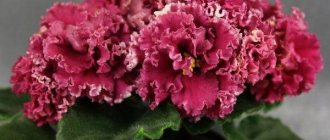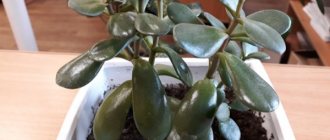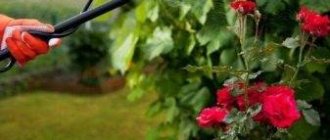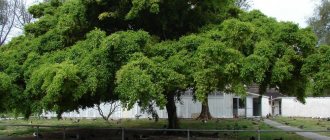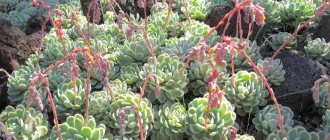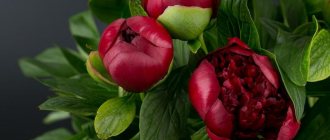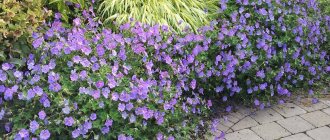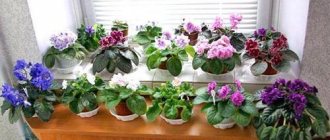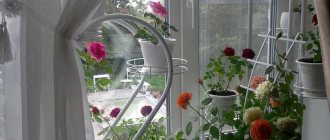The carnation is a modest, delicate flower with a soft and enchanting charm. However, its name is not at all modest - in Latin, carnation is “Dianthus”, which means “Flower of God”. It was believed that the Gods of Olympus were crazy about these cute flowers. The religious significance of carnations is difficult to overestimate - at all times, representatives of different faiths used carnations for rituals, since it was believed that the flower is the earthly embodiment of the divine.
During World War II, the carnation became a symbol of innocently shed blood and honoring the memory of the dead. In the USA, carnations are traditionally given on Mother's Day - there the flower means gratitude for the unconditional love of parents. But in China, white carnations are considered wedding flowers - they are used to decorate the bride’s outfit.
In Korea, fortune telling with carnations is popular among young girls. Young beauties weave three buds of these amazing flowers into their hair. If the top flower withers first, the girl will face a difficult, difficult old age, if the middle one, the most difficult times will be at a young age, and if the bottom one withers first, failures will lie in wait throughout her life.
Often the meaning of carnations depends on the color of the petals. White flowers are a symbol of trust, sincerity and purity of thoughts, red ones are, of course, a sign of ardent and passionate love, but striped flowers are a kind of “consolation prize” for the person you are forced to refuse.
For some reason, in our country these flowers are associated only with cemeteries and Victory Day. Of course, carnations are great for expressing gratitude and sorrow, however, their role is not limited to this. They look great both at holidays and as an expression of feelings - you just have to abandon the usual patterns. These inexpensive flowers have a special charm - be able to notice this without thinking about how many people are accustomed to interpret the meaning of carnations due to lack of awareness.
Regardless of what meaning you attach to flowers, you have to agree that carnations have a unique aesthetic. In our selection we will introduce you to the most beautiful varieties of this plant.
Heddeviga chinensis
In the nineteenth century, large-flowered carnations were brought to Russia from Japan, which were later called “Geddevia sinensis” - in honor of Karl Heddevig, who was a gardener at the St. Petersburg Botanical Garden. These unpretentious flowers can tolerate anything - frost and drought, although they still need care and feeding. Heddeviga chinensis will decorate any garden plot and fit perfectly into the landscape. Flower growers adore this plant - and, it must be said, for good reason, because thanks to Chinese carnations they do not have to make a choice between aesthetics and ease of maintenance. If you decide to decorate your flowerbed with Hedwiga sinensis, plant the flowers on the sunny side - this will ensure good growth.
How to prepare and store
In folk medicine, the herb and roots of cloves are used. The herb is harvested while the plant is flowering: collected and dried in a well-ventilated area, avoiding direct sunlight, or in a special dryer at a temperature of 50°C. Dried herbs are stored in fabric bags for no longer than two years. Clove roots are usually used fresh to make a tincture.
This plant is collected mainly during its flowering period, that is, at the end of summer:
- After collecting field carnations, they are sorted and sorted. When sorting the collected plant, it is necessary to remove deformed specimens.
- Next, the collected flowers and leaves must be spread in a thin layer on a tray.
- This raw material must be turned over regularly. This will keep it from getting damp. Otherwise, the collected potion may become damp and lose all its healing properties.
- To simplify the process of drying field cloves, it is best to use a special drying chamber. With this automatic tool, you can eliminate the hassle of turning over your grass every day.
- Also, thanks to this unit, you can set the required temperature, with which the grass will be dried efficiently and not lose its beneficial properties.
- When the grass is completely dried, it is necessary to package it. For this purpose, bags made of ordinary fabric are used.
- Storage of dry grass should not exceed two years. After this period, the field clove will lose all its beneficial properties.
Merry go round
The beauty of the large white flowers with a red spot in the middle is truly mesmerizing. Merry go round is a variety that looks festive, joyful, and creates a special atmosphere. If you have been missing something that can help fight depression and feed positivity from the outside, pay attention to these carnations. They look especially impressive in a flowerpot on the porch. Neat, small flowers will appeal to those who are looking for something bright, but at the same time not too provocative.
Interesting facts about cloves:
- According to ancient Greek myths, the carnation plant appeared on earth due to the wrath of the wayward Artemis. One day, returning after a bad hunt, the goddess took out her anger on an innocent shepherd boy, blaming him for her failure. As punishment, she tore out his eyes and threw them to the ground. From them grew two blood-red flowers with dark spots in the middle, symbolizing innocently shed blood and the black pupils of the eyes.
- During the French Revolution, supporters of the king sentenced to execution ascended the scaffold with a white carnation pinned to their clothes. For a long time, the white carnation was called the flower of horror.
- For the inhabitants of England and France, the carnation flower testified to belonging to the highest nobility, although for the Belgians it was the flower of the common people.
- Carnation flowers are edible, they are used to decorate cakes and even make liqueur from them. But they can cause food poisoning in pets.
Marie Chabot
We owe the opportunity to contemplate such beauty to the pharmacist Chabot from Toulon, who lived in the nineteenth century. Yellow flowers will perfectly decorate a flower bed, balcony, terrace, gazebo. If you are the owner of a small cozy cafe, we recommend this particular variety to decorate the landscape of the establishment. However, flowers are also suitable for cutting - after all, what girl would refuse the opportunity to receive a bouquet of sunny carnations? Marie Chabot are flowers with a subtle, refined aroma, and if you are partial to smells, pay attention to this variety.
Mikado
The “Mikado” variety is sure to become your favorite if you prefer delicate, discreet flowers. The lilac shade looks both gentle and mysterious - by the way, this color is considered the most fashionable in the summer of 2020. These flowers are well suited both for decorating the veranda and for cutting - lilac bouquets look simply amazing. We must warn you that this variety is not so easy to care for - this is unlikely to scare experienced plant growers, but beginners should choose something simpler. During the rainy season, fungal diseases in flowers are possible.
Fire King
There is a belief that this particular variety protects the home from evil spirits and prevents misfortunes on the road. It also symbolizes kindness, justice, loyalty and devotion. Large red-orange flowers look catchy, impressive and bright - so we must warn that they cannot fit into any scale, as they can draw all the attention to themselves. The aroma of these flowers will not leave anyone indifferent, so we would recommend them for cutting and gifting. If you want to please a sultry, extravagant and temperamental girl, give her “Fire King” carnations.
Habitat and places of growth
This plant is a typical inhabitant of temperate climate areas of Eurasia with predominant vegetation in the form of deciduous or mixed forests. In addition, it feels good in forest-steppe conditions and motley grasses of wet steppes.
The name of the field carnation comes from the place where it grows. It is a typical meadow perennial, growing in fields as a weed and also in non-boggy meadows.
Meadows are a kingdom of grasses with a developed root system, rhizomes, bulbs, tubers and other devices that allow the plant to take over space and keep it from other species.
Thanks to the rhizomes, the flower can quickly grow back after damage and prevent other plants from entering the conquered territory. It is with this strategy that the carnation forms carpets of pink blooms or contributes its color to the meadow variety of bright flowers.
Field carnation is very resistant to haymaking and grazing, but does not tolerate fires and trampling. For this reason, it is part of the grass stand of forest glades and treeless dry areas where hay is cut and cattle are grazed, but disappears from areas where many people walk and frequent burning takes place.
La France
La France is considered one of the best varieties of pink carnations. The delicate powdery shade looks incredibly gentle and elegant. The bushes are tall, the variety is well suited for cutting. The aroma is very pleasant, fresh and spicy at the same time. We advise you to pay attention to “La France” if you want to enjoy flowering for as long as possible - these carnations can delight you right up to October.
Signs and superstitions
Cloves have many magical properties, one of which is protection from negative energy, hostile influences and witchcraft. In addition, this flower can stop gossip and bad language. Carnations also strengthen memory well, and if you make a necklace of buds and string them on a red thread, this will become a good amulet for young children.
Also, the smell of cloves “helps smooth out internal contradictions” and “stimulates positive emotions”
In the Middle Ages, when the Catholic Church organized a witch hunt, only the carnation could protect people with extraordinary abilities (for this you had to always carry this flower with you). Naturally, cloves were actively used in various protective spells and magical rituals. It was given to a sick person, as it was believed that this flower had strong healing properties.
Cloves (or rather the inflorescences and roots of the plant) were also used as a love spell, and clove amulets contributed to self-improvement, the development of confidence and perseverance. In addition, cloves help to cope with indecision and enhance vitality.
Canta libra
Very expressive, spectacular and bright carnations. Plant growers claim that the Canta Libra variety is hardy and easy to care for. These are miniature flowers that go well with other plants and harmoniously complement their beauty - pay attention to this when composing bouquets. If you are going to decorate the clearing around your house, these crimson and red flowers will be an excellent solution. However, be careful when weeding - due to the modest size of these carnations, they will simply not be visible in thickets of grass.
Cloves - beneficial properties.
Cloves are not only a beautiful ornamental plant, but are also widely used in medicine to treat various diseases. The chemical composition of cloves is a real storehouse of vitamins and microelements necessary for human life: potassium and sodium, iron and copper, zinc and magnesium, ascorbic acid, beta-carotene, proteins, carbohydrates, as well as essential oils and tannins.
Preparations made from cloves can have a sedative, analgesic, hemostatic and diaphoretic effect. When taken internally, they are used to stop uterine bleeding, treat diseases of the genitourinary system, and relieve headaches. External use of clove decoctions and tinctures allows you to get rid of dermatitis and inflammation of the mucous membranes, and clove essential oils help in the treatment of respiratory diseases.
Maiden pink
The “Maiden Pink” variety is a wonderful decoration for a flower bed or flower garden. These are miniature carnations that bloom profusely. They are absolutely unpretentious in care and are suitable for beginner plant growers. “Maiden Pink” is not as popular as “Canta Libra” - therefore it is suitable for those who want to emphasize their originality. Small crimson flowers look bright and delicate at the same time.
Canary
The “Canary” variety with bright lemon petals is one of the best for garden decoration. Like most varieties of carnations, “Canary” prefers sunny, well-lit areas. In the wild, these flowers can be seen in Italy, Hungary and Romania. Small yellow flowers have a modest, delicate beauty. Flowering begins in mid-July and ends by September.
Main types, varieties
To truly appreciate the luxury and splendor of this culture, place several different carnations in your dacha at once - you will love them all.
And seeds of various types of cloves can be selected in our catalog, which contains offers from many large gardening online stores. Select clove seeds. Carnation pinnate Terry Fairy tale, Mixture, 0.1 g 32 RUR
seedspost.ru
Carnation heddevig Dolly Doll, Mixture, 0.5 g 25 rub.
seedspost.ru
Carnation pinnate Spring beauty, Mixture, 0.1 g 32 rub.
seedspost.ru
Cloves - grass Night fire, 0.1 g 26 rub.
seedspost.ru
Dianthus deltoides
Now it is already a frequent guest of country flower beds, and recently many gardeners have not even heard of such a carnation.
She comes from Europe and Asia. Dianthus grass. Photo by the author This is a dense turf perennial up to 20 cm high and about 30 cm wide. The leaves are dark green, 1-1.5 cm long. The flowers are single, white, pink, red, with a ring in the center.
Decorative varieties:
- 'Brilliant' (bright crimson flowers);
- 'Leuchtfunk' (bright red flowers);
- 'Arctic Fire' (light pink flowers, bright crimson center).
Dianthus grass, variety 'Arctic Fire'.
Photo by the author For more information about the varieties of this carnation, see the publications:
- 10 ideal plants for a sunny rock garden
- Dianthus grass
Practical advice. When rejuvenating a carnation bush, the plant is severely pruned to the ground. The apical herbaceous shoots of this year with 2-3 internodes can be taken as cuttings. In moist, clean river sand they take root quickly, in about 2 weeks.
Imeretian carnation (Dianthus imereticus)
Endemic to the Caucasus;
in nature it grows on gravelly places in Western Transcaucasia. Imeretian carnation. Photo from the site plantarium.ru This is a perennial rhizomatous plant with numerous stems 30-60 cm high. The leaves are bluish-green, 4-10 cm long. The flowers are pink, the petals are finely toothed, up to 2 cm in diameter, bloom in June-August. Flowering is remontant: it blooms again in the fall. One plant can have from 2 to 10 flowers.
Practical advice. Propagate this carnation by seeds, because their germination rate in the first year of storage is very high, up to 80%! Remember that seedlings bloom in the second year.
Chinese carnation (Dianthus chinensis)
One of the most unpretentious annuals for central Russia.
Chinese carnation. Photo by the author She comes from China. It grows up to 70 cm in height, 16-23 cm in width. Leaves are up to 8 cm long. Flowers up to 8 cm in diameter, pink, red, white, often with purple eyes, bordered with intricate patterns up to almost half the length of the petals, single or collected into corymbose inflorescences. One plant can have up to 15 flowers; It blooms in summer and autumn, for a long time, until real frost. On the Southern Coast of Crimea (SC) and the Black Sea coast of the Krasnodar Territory it can winter without shelter.
Mix with Chinese cloves
Practical advice. For early flowering - in April - you can sow carnation seedlings as early as January. But plants sown in April will bloom in mid-summer and will bloom until October.
Dianthus plumarius
Another European species.
This is one of my favorite plants, a flower that reminds me of my mother. Clove pinnata. Photo by the author An evergreen perennial 25-30 cm high. The leaves are silver-green, narrow, sometimes twisted, 10-12 cm long. The flowers are fragrant, small, can be simple or double, solitary, 3 cm in diameter; white, pink, with a ring in the center, petals with fringed-cut edges, variegated; bloom in July-August (in the south - from May).
Practical advice. Grown, strengthened and hardened carnation seedlings are planted in a permanent place in May, maintaining a distance of 20-25 cm between plants.
Rock carnation (Dianthus petraeus)
This beauty comes from South-Eastern Europe, Romania, and the Balkans.
Rock carnation. Photo from the site plantarium.ru This is a creeping perennial 15 cm high and up to 20 cm wide. Leaves are 2.5 cm long. The flowers are fragrant, white, light pink, 1 cm in diameter; bloom in summer.
Practical advice. Use perennial low-growing fragrant carnations for border plantings near garden paths, in rockeries, and mixborders. In addition to those described in the article, the varieties of garden (D. caryophyllus), greyish-blue (D. gratianopolitanus), sandy (D. arenarius) and many others have very fragrant flowers.
Dianthus superbus
Slightly "shaggy" appearance.
It comes from the mountainous regions of Europe and Asia. The carnation is lush. Photo from the site plantarium.ru This perennial is 20 cm high and wide. The flowers are fragrant, purple-pink, pink, 4-6 cm in diameter; bloom from mid-June to the end of July.
Practical advice. Lush carnations can be grown in containers. The optimal soil substrate is a mixture consisting of humus, leaf soil, turf soil, and sand, taken in a ratio of 2:1:1:2. For every 10 liters of mixture add 1 tbsp. spoon of complete mineral fertilizer (NPK) and crushed chalk.
Yellow harmony
Another wonderful variety for those who adore flowers of a beautiful sunny shade. The petals are very bright - such carnations perfectly lift your spirits and charge you with optimism. The bushes are tall, with erect stems. “Yellow Harmony” has a very pleasant aroma. However, we would not recommend this variety to those growers who are afraid of annoying insects - these carnations are very attractive to them.
Carnation flowers in cooking
The tender petals of garden or Chinese cloves are used for food. These edible flowers are slightly sweet in taste and very fragrant. Before using them as food, remove the base of the petal as it has a bitter taste.
What other flowers can be eaten, read the article:
"Edible flowers and their types"
Chartreuse - traditional French liqueur
With colorful petals, you can liven up your casseroles, salads and sandwiches. Cloves can be used as a spice and added to wine to make mulled wine. Clove petals can also be candied and used in cakes and other sweet baked goods as a living decoration.
During the Renaissance (15th-17th centuries), clove petals became the main ingredient of Chartreuse , a liqueur prepared by the monks of the Carthusian order in the wine cellars of the commune of Voiron on the border of the Chartreuse mountain range in the Pre-Alps.
Ruby
Suitable for those who are looking for flowers that can decorate the site all year round - even when flowering ends, the “Ruby” variety still looks decorative due to the bluish-blue color of the leaves. The flowers are small, but look very festive and cheerful. The rich ruby hue will attract aesthetes who admire deep, rich tones. We must warn you that the variety does not tolerate high humidity, so try to provide the plant with good drainage. Oddly enough, these carnations feel great in sand or rocks.
Garden carnation: planting and care, cultivation, photo.
Choosing a place to plant carnations.
The place for planting carnations in open ground must be selected carefully. This is a light-loving plant that prefers areas well lit by the sun, without stagnant groundwater. The soil for growing cloves should be light, with neutral acidity and a significant admixture of sandy loam. If the soil on the site is more dense and acidic, peat and dolomite flour are added to it.
Fertilizers.
To provide the plant with the necessary trace elements and minerals, well-rotted manure and superphosphate at a rate of 50 g/m2 must be added to the soil in the fall. After the snow melts, before digging the area, potassium sulfate (25 g/m2) and ammonium nitrate are added to the soil.
Annual carnations also need fertilizing, which should preferably be done in 2 stages. The first is carried out with ammonium nitrate (15g/m2) 7-8 days after planting the seedlings in the ground. Second, during the period of mass formation of buds, you need to feed the cloves with a mixture of nitrate and potassium sulfate.
Weiss
An excellent decoration for a wedding bouquet - lush white inflorescences look luxurious, expensive and solemn. At the same time, these carnations are the real personification of tenderness. The “Weiss” variety is also ideal for decorating a personal plot - it has long flowering and will delight you for a long time. The aroma of flowers is delicate, subtle, refined. Unlike most other varieties of carnations, the Weiss variety grows well in partial shade and tolerates frost.
Lady in Black
The dark burgundy double flowers look sophisticated, elegant and dramatic. This color has always symbolized restraint, aristocracy and good manners. These carnations are perfect both for decorating flower beds and for cutting. The aroma is subtle and pleasant - believe me, the smell of the “Lady in Black” variety will not leave you indifferent. This is not a carnation variety that thrives with minimal care - we recommend purchasing Lady in Black seeds only if you already have experience in growing plants.
Field carnation propagation
Field cloves can be propagated by seeds or by dividing the bush. The root system of the flower is restored very quickly after transplantation. The main thing is to provide the plant with regular watering and light loosening until it is completely rooted.
It is better to plant adult specimens with rhizomes in the fall - in September or early October. The main thing in this case is to calculate the time so that the plants have time to take root, but do not begin to actively vegetate. You can replant in the spring, but then there will be no flowers this year.
- Before sowing this plant, you need to mix the soil with sand.
- Seeds can be sown both in spring and autumn.
- When sowing in spring, the wild carnation leaves within 12-18 days.
- If you plant this plant in the fall, then it will rise in the month of April.
Carrot King
One of the most popular varieties of carnations, plant growers simply adore the “Carrot King”. It blooms from July to August, quite profusely. Despite the fact that these carnations are considered frost-resistant, we still recommend planting them on the sunny side of the site. Quite unpretentious in care, does not require large expenses for maintenance. Try to protect flowers from rodents - they are the main natural enemies of carnations.
Sowing
In moist and compacted soil, make rows 3-4 mm deep. The distance between them is 2.5-3 cm. The seeds are laid out at a distance of 1.5-2 cm from each other.
Cover the cloves not with soil, but with sterile sand (calcined in a frying pan or oven). The crops are sprinkled with warm water on top.
The boxes with cloves are covered with film and put in a warm place (+19..22 degrees). Shoots will appear within 3 weeks. During this time, the crops must be ventilated daily and, if necessary, the surface of the soil must be sprayed with water.
@sakura, Flickr
Badenia
Refers to needle-leaved carnations. In nature, such flowers can only be found in the Southern Urals, in rocky steppes, on rocks and river banks. The flowers are large, with a thick and rich aroma, the petals are a very beautiful, bright crimson color. The variety is excellent for decorating flower beds, verandas, and garden plots. However, those who experience headaches from strong odors should avoid growing “Badenia”.
Timing for sowing cloves for seedlings
In the domestic climate, it is customary to first sow carnations as seedlings, planting the grown bushes in the ground after warm weather sets in. This gives the race in time necessary for the early flowering of carnations.
Depending on the region, flowers are sown at the following times:
- in the middle zone and the Moscow region - in March;
- in the north, the Urals, in Siberia - from late March to mid-April;
- in the south - in mid-February.
Ready seedlings are planted in the garden in May - June.
@Jason Girouard, Flickr
Landing dates according to the lunar calendar for 2022
When to plant annual carnations:
| Month | Better days | Month | Better days |
| January | 23-27 | April | 3-7, 12-15, 21, 22 |
| February | 4-14, 17-23 | May | 2-5, 12-14, 18-25 |
| March | 3-16, 20-21 | June | 1-3, 6-13 |
When to plant perennial cloves:
| Month | Better days | Month | Better days |
| January | 25-27, 29-31 | July | 6-8, 23-27, 30, 31 |
| February | 3-14, 17-23 | August | 2-6, 8-10, 12, 14, 22-24, 29-31 |
| March | 3-8 | September | 5-8, 13-15 |
| April | 3-7, 12-15, 25-30 | October | 2-4, 8-15, 20-22 |
| May | 2-5, 7-12, 18-25, 27-29 | november | 3, 4, 9-12, 19-23 |
| June | 1-3, 6-8, 23-26 | December | 1, 2, 4-6 |
In 2022, unfavorable days fall on the following dates:
- January – 2, 3, 17, 18
- February – 1, 2, 16, 28
- March – 1, 2, 18, 27, 28
- April – 1, 2, 16, 23
- May – 1, 16, 30
- June -14, 18, 29
- July – 13, 14, 28, 29
- August – 11, 12, 27-28
- September: 9-10, 26, 27
- October: 9, 10, 25, 26
- November: 1, 2, 7-9, 24, 25, 28, 29
- December: 7-9, 23-25
Sooty
Perhaps “Sooty” is the most unusual variety of carnations that exists. Dark velvet petals look elegant and dramatic. Many gardeners consider “Sooty” carnations to be one of the best garden flowers. If you're looking to make your landscape truly unique, these carnations are the best you'll find. This variety is perfect for decorating flower beds, landscape gardens, and terraces.
Black Molly
Many people who see the “Black Molly” variety for the first time are perplexed - these flowers don’t even look like carnations! The cosmic flower is loved by florists and bloggers who create unique content on Instagram and Pinterest. It seems to us that such carnations can make any bouquet much more stylish and original. Flowers of an ash-violet hue are truly rare and stunningly beautiful. We recommend giving someone a bouquet of these unique flowers for their birthday - we are sure the birthday person will be delighted.
A closer look at the noble flower
How nice it is that caring people take a close look at the plant kingdom around us. Their admiration is reflected in songs and poems that remain on the lips of several generations for a long time. What attracts the prim carnation? With its originality.
Interestingly, the flower was called “carnation” by German plant researchers. The reason for this was the exquisite smell that the plant exuded, reminiscent of the oriental spice of the clove tree. In fact, the plants have nothing in common.
The famous Swedish botanist Carl Lineus, admiring the unusual flower, gave it the name “Dianthus”. Translated into Russian it means “divine flower”. Today, there are over 300 different species of carnations in the natural environment. They are all classified as annuals, biennials and perennials, which have different characteristics. The only thing they have in common is the magnificence of their elegant buds.
Considering different varieties of the plant, biologists discovered that carnation flowers are:
- in a single version;
- in the form of a panicle;
- luxurious shield;
- small;
- large;
- simple;
- terry;
- with a pleasant smell;
- no aroma;
- with smooth petals;
- with serrated tips of inflorescences.
The calyx of the bud has the shape of a miniature cylinder. In its upper part there are 5 tiled petals of various colors. They surround ten graceful stamens and one slender pistil. Each petal has a velvet base, the edges of which are decorated with original fringe. Truly a majestic flower!
The original shoots of cloves are:
- smooth structure;
- herbaceous in nature;
- with the presence of nodules;
- single;
- with many branches;
- slightly woody.
They grow linear leaves located opposite each other in various green shades. In some species they are grassy in color, in others they are dark green. But they are all covered with a bluish-silver coating.
When the flowering period passes, fruits appear on the plant in the form of miniature boxes. They are filled with a huge number of shiny black or brown seeds. Interestingly, they can be round, oval or flattened. But this does not in any way affect the germination of the seeds; each of them carries information about the original variety of carnation.
The flower is widely used for landscape design of garden areas. They decorate borders, rock gardens, flower beds and lawns. The plant grows well through the seams of paving slabs, making it an indispensable outdoor decoration.
